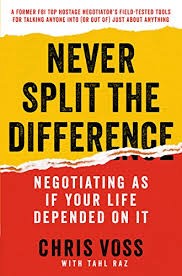Never Split the Difference

Never Split the Difference is the first book I’ve read about the art of negotiation — the other book closest to this one was Influence by Robert Cialdini (review). In this book, Chris Voss, a former international hostage negotiator for the FBI, lays out his approach to high-stakes negotiations and offers a few key lessons that you can incorporate in your daily routines. Negotiation is the heart of collaboration, and is what makes conflict potentially meaningful and productive for all parties. Chris Voss also explains why approaches popularized by other popular books like Getting to Yes are not as effective — they tend to leave a lot on the table by anchoring you to the Best Alternative to a Negotiated Agreement (BATNA) at the start, thereby leaving out possibilities that that you could’ve uncovered during the negotiation.
There are a bunch of great ideas in this book — so this is going to be a long one. Let’s jump right in:
Be a mirror
Begin with listening and validating the emotions of your counterpart, and create enough trust and safety to begin a real conversation. Use a late-night FM DJ voice and repeat back the critical one to three words of what the other party says. Your counterpart will elaborate on what was said and sustain the process of connecting. A playful voice puts your counterpart in a positive frame of mind, where they would be more likely to collaborate with you.
Don’t Feel Their Pain, Label It
Good negotiators precisely label emotions and then talk about them without getting wound up. With labeling, we turn someone’s feelings into words, and then very calmly and respectfully repeat their emotions back to them. It has a special advantage when your counterpart is tense because exposing negative thoughts to daylight makes them seem less frightening.
The first step to labeling is detecting the other person’s emotional state, usually by inspecting their words, tone, and body language. Then label it aloud with “It seems/sounds/looks like…” Don’t use “I,” which makes you seem self-interested, and makes you take personal responsibility for what follows. The last rule of labeling is silence. Be quiet and listen.
Beware “Yes”, Master “No”
Instead of taking your counterpart through a line of reasoning where they say “yes” to all your assertions/questions, take them through one that lets them say no. By giving someone permission to say “no” to your ideas, you calm down the emotions on the other side and increase effectiveness. Another helpful tip from this chapter: if your emails are being ignored, provoke a “no” with the one sentence email: “Have you given up on this project?”
Trigger the Two Words That Immediately Transform Any Negotiation: “That’s Right”
Before you convince someone to see what you’re trying to accomplish, you must say the things to them that will get them to say “that’s right.” A good summary is the combination of re-articulating the meaning of what is said plus acknowledging the emotions underlying that meaning. Beware of “You’re right” — like “yes,” it’s a social lubricant that is not a substitute for real understanding between two parties.
Bend Their Reality
Never split the difference. Creative solutions are almost always preceded by some risk, annoyance, confusion, or conflict. If you internalize “No deal is better than a bad deal,” then your patience can become a powerful weapon. The most powerful word in negotiations is “fair.” We comply with agreements if we feel we have been treated fairly, and lash out if we don’t. Using the phrase “We just want what’s fair” destabilizes the other side. If your counterpart uses it on you, instead of conceding irrationally, apologize, and offer to go back to where the unfairness began and fix things. Some practical tips here:
- Let the other side anchor monetary negotiations, since you often don’t know enough to open with confidence.
- Be prepared to withstand the first offer. It could be extreme to bend your reality.
- Establish a range in your offer. Expect your counterpart to come in at the low end, so make the low number what you actually want.
- Anchor your counterpart high, then make your offer seem reasonable by offering things that aren’t important to you but could be important to them.
- Similarly, if their offer is low, then ask for things that matter more to you than to them.
- Numbers that end in 0 feel like temporary placeholders. Numbers that sound less rounded feel serious and permanent to your counterpart.
- A wholly unrelated surprise gift can make extreme anchors palatable because they introduce a dynamic of reciprocity.
- When negotiating a salary, be pleasantly persistent on non-salary terms. The more you talk about them, the more you’ll hear the full range of options.
Create The Illusion Of Control
The calibrated, or open-ended, question acknowledges the other side openly, while letting you introduce ideas and requests without sounding pushy. The calibrated question forces the other party to pause and actually think about how to solve the problem. Giving the illusion of control like this suspends “unbelief,” or complete rejection to what the other side is saying. Calibrated questions avoid “can,” “is,” “are,” “do,” or “does,” which can be answered with a simple “yes” or “no.” Start questions with “what” and “how.” “Who,” “when,” and “where” will cause your counterpart to share a fact without thinking. “Why” can sound accusatory. Only use “why” when the defensiveness that it creates supports the change that you are trying to get them to see. The question “What is the biggest challenge you face?” gets the other side to teach you something about themselves. A well-designed calibrated question implies that you need the other party’s intelligence to overcome the problem, which appeals to very aggressive or egotistical types.
Guarantee Execution
Your job isn’t just to get to an agreement, but to get to one that can be implemented and making sure that it happens. The 7–38–55 rule says 7 percent of a message is based on words, 38 percent from tone of voice, and 55 percent from body language and facial expressions. When someone’s tone of voice or body language is incongruous with their words, use labels to discover its source. The Rule of Three is getting the other party to agree to the same thing three times. This uncovers falsehoods and the aforementioned incongruence. To avoid sounding like a broken record, label or summarize, or use calibrated questions to hear agreement three times. The Pinocchio Effect says that liars use more words, speak in more complex sentences, and use far more third-person pronouns. Be watchful of that.
Bargain Hard
Negotiators fall into three categories: Accommodators, Assertives, and Analysts.
- Analysts are methodical and diligent. They are not in a big rush, and their self-image is linked to minimizing mistakes. Analysts work alone, rarely show emotion, extensively prepare, are hypersensitive to reciprocity, are skeptical, value silence, and don’t value apologies. As an analyst, smile when you speak, so that you are not cut off from an essential source of data, namely your counterpart.
- Accommodators value most the building of a relationship. They value the time communicating and want a win-win. If your counterpart is an accommodator, ask calibrated questions to translate their talk into action. As an accommodator, do not sacrifice your objections, and beware of excessive chitchat, especially if your counterpart is one as well.
- Assertives believe time is money. Their self image is linked to getting things done, and getting things perfect isn’t paramount. Focus on what assertives have to say, because until they are convinced you understand them, they won’t listen to your point of view. Mirrors, calibrated questions, labels, and summaries work well with assertives, who see every silence as an opportunity to speak more. As an assertive, be conscious of your tone. Use calibrated questions and labels to make yourself more approachable.
Ackerman bargaining: Set your target price as a nonround number, then offer 65, 85, 95, 100 percent. Use empathy in between offers. On your final offer, throw in a non-monetary item.
Find The Black Swan
Black Swans are events or pieces of knowledge that sit outside of our regular expectations and therefore cannot be predicted — uncovering them in your negotiations can give you a huge leg up. They are leverage multipliers. Leverage, or the ability to inflict loss and withhold gain, can always be manufactured. Positive leverage is the ability to provide or withhold things that your counterpart wants. Negative leverage is the ability to make a counterpart suffer, and is based on threats and preys on loss aversion. Black swans as negative leverage include what is important to them, such as what signifies status to them or what worries them. Email is a bad medium for finding Black Swans: counterparts have time to think and re-center themselves, and you can’t read non-verbal parts of a response.
To wrap this up, remember that every negotiation, every conversation, every moment of life is a series of small conflicts that can rise to creative beauty. Embrace them. The first step to achieving a mastery of daily negotiation is to get over your aversion to negotiating.
This is #49 in a series of book reviews published weekly on this site.
